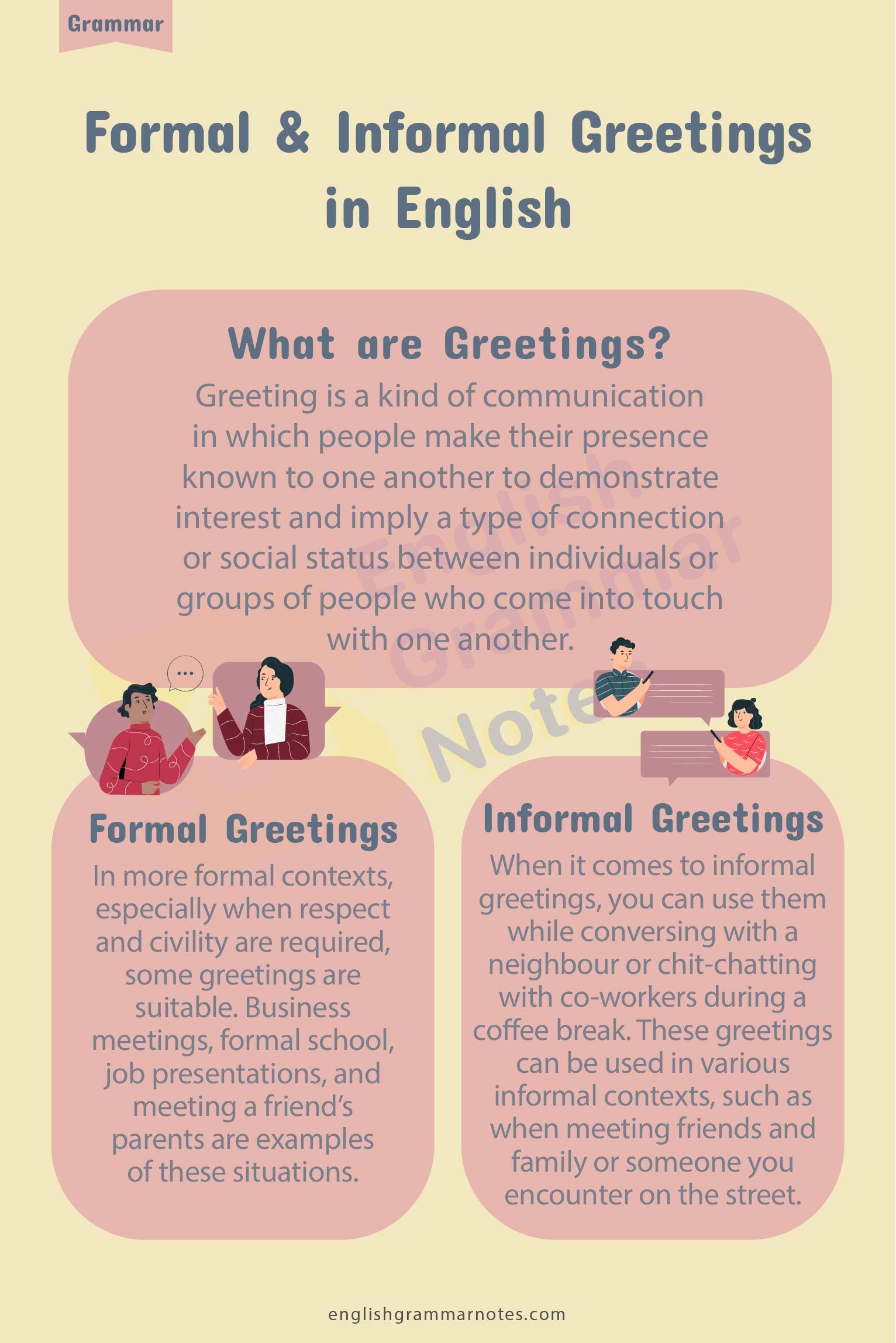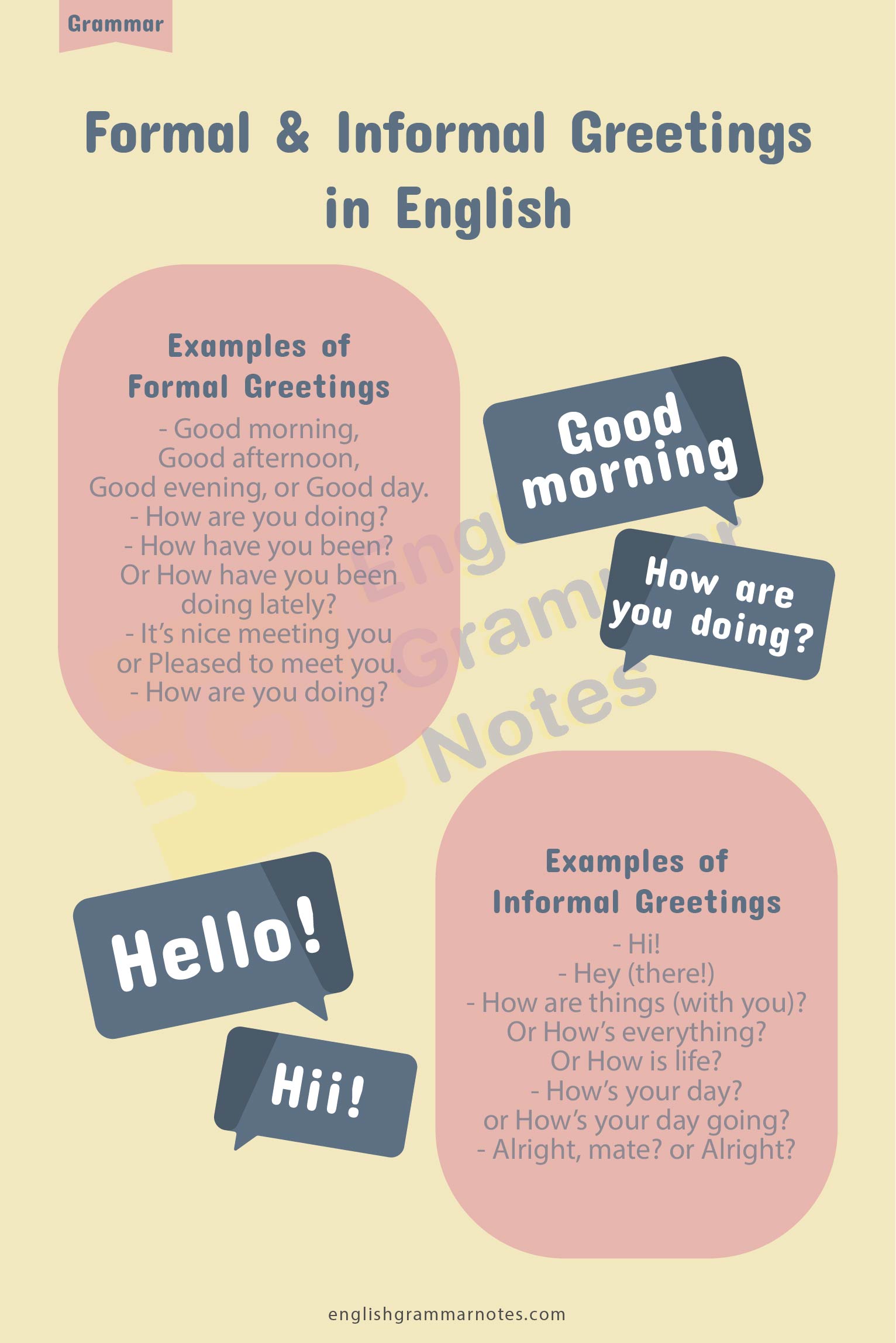Formal and Informal Greetings in English: Every nation or culture has its unique greetings, which are a part of every discussion. Consider how you greet newcomers in your home country. There are many traditions to follow in English, just as there are different ways to say “hello” in your original language. It’s crucial to understand the most popular greetings and responses in English and use them correctly and confidently.
You’re probably already familiar with a few different ways to say “hello” in English, but you are yet to know and be surprised about how many types of greetings exist in a single language – far too numerous to mention here.
A well-chosen “hello” sets the tone for every discussion, whether you’re speaking with a close friend or a complete stranger, and hence here in this article, you will get to see such examples of greetings along with their meanings that will help you to choose the appropriate greeting for a formal or casual setting.
Formal and Informal Greetings
- What are Greetings?
- What are Formal Greetings?
- Examples of Formal Greetings
- What are Informal Greetings?
- Examples of Informal Greetings
- The Takeaway from the Article
What are Greetings?
Greeting is a kind of communication in which people make their presence known to one another to demonstrate interest and imply a type of connection or social status between individuals or groups of people who come into touch with one another.
Simply said, a greeting is a means of expressing hello to someone. This may be practised in various ways in the English language. Some greetings may be used in official contexts, as well as greetings that can be used in a more casual, friendly environment. It is crucial to be able to pick a suitable welcome for any circumstance.
What are Formal Greetings?
In more formal contexts, especially when respect and civility are required, some greetings are suitable. Business meetings, formal school, job presentations, and meeting a friend’s parents are examples of these situations.
When doing business at restaurants and stores, you may receive similar welcomes. If you’re ever in question about whether to give a formal or casual greeting, it’s usually best to go with the formal to avoid offending someone.
Examples of Formal Greetings
Formal settings and official situations demand greetings in a formal manner unless the other person greets in a casual way. Some of the most famous greetings for formal occasions are listed below.
- Good morning, Good afternoon, Good evening, or Good day – These formal greetings are commonly used in a formal atmosphere and are used as a replacement for the word “hello.” Before 12 p.m., you should say ‘good morning,’ after 12 p.m., you should say ‘good afternoon,’ and after 6 p.m., you should say ‘good evening.’ The phrase “good day” can be used at any time throughout the morning or afternoon.
- How are you doing? – Although this is an ancient greeting, it is still commonly used in formal circumstances. When you ask this question, you’re likely to get a response like “quite good, thank you.”
- How have you been? Or How have you been doing lately? – Only those who have met before can ask this greeting question to each other. When someone asks, “How have you been?” they want to know if you’ve been doing fine since the last time you saw or met each other.
- It’s nice meeting you or Pleased to meet you – When meeting someone for the first time, this is a common greeting. It is most commonly used in formal settings, although it may also be used in a less formal setting for a first encounter. Remember to use these pleasantries only when meeting someone for the first time. “It’s wonderful to see you again,” you might remark the next time you see the individual to convey that you remember him or her.
- How are you doing? – This is a polite method of inquiring how someone is doing, and it’s frequently used with words like ‘hello’ or ‘good morning or afternoon or evening,’ etc.
What are Informal Greetings?
When it comes to informal greetings, you can use them while conversing with a neighbour or chit-chatting with co-workers during a coffee break. These greetings can be used in various informal contexts, such as when meeting friends and family or someone you encounter on the street.
Although some of these statements appear to be queries or questions, the greeting is not necessarily expected to be responded by the greeted. In reality, as perplexing as it may seem, a question is occasionally answered with a question. These greetings can also be used in combination, as seen in the examples below.

Examples of Informal Greetings
Below are some informal greetings that you may use with English-speaking friends, relatives, or anybody else with whom you’re familiar.
- Hi! – This is another term for ‘hello’ and is arguably the most widely used greeting in English. In everyday life, you’ll hear this greeting rather frequently.
- Hiya – This is a variation of the above-mentioned ‘hi,’ and is often used in the United Kingdom.
- Hey (there!) – A different take on the word “hello.” This is a cheerful and optimistic welcome.
- Morning! – This is a more informal or casual way of greeting “Good morning” to someone you see frequently or on a regular basis.
- How are things (with you)? Or How’s everything? Or How is life? – Instead of the more formal query, “How are you?”, often this less strict expression is used.
- How’s your day? or How’s your day going? – These phrases simply mean “how are you?” not only now but throughout the day. These greetings are used later in the day and with someone you meet frequently.
- What’s new? Or How’s it going? Or What’s going on? – This is an informal manner of asking someone how they are, and it is frequently substituted for “hello.”
- How are you? – This is another method of inquiring how someone is doing, and it is often used in English.
- What’s up? Or ‘Sup? – It is a slang phrase that means ‘what’s up?’ and is more prevalent in the United States. Many individuals use the phrase “what’s up,” however it is frequently reduced as “sup.
- It’s great to see you again, or Long time, no see, or It’s been a while – When you run into someone you haven’t seen in a long time and meet them unexpectedly, you say this greeting.
- Nice to see you or Good to see you – These informal greetings are used when you haven’t seen friends, co-workers, or family members in a long time.
- Yo – This is another informal or casual greeting that is more popular in the United States, and it simply means ‘hello, what’s up?’
- Howdy! – This is a very casual shorthand of “how do you do?” that is widespread in portions of Canada and the United States’ southern regions. Keep in mind that saying “howdy” outside of these areas will make you sound like a cowboy, which may make the other person chuckle.
- Alright! – This is a fairly frequent greeting in the United Kingdom that is used to say hello to someone.
- Are you OK? Or You alright? Or Alright, mate? – In Britain, this informal style of saying “hello” and “how are you?” is prevalent. “Yeah, fine,” or just “alright,” is an acceptable response for these greetings.
- Alright, mate? or Alright? – This is a frequent slang technique of greeting a buddy in a relaxed manner. It’s a condensed form of “Are you okay?” “Not bad, mate, you?” is an appropriate and pleasant response as well.
- G’day! – It’s a contraction of “Good day.” This informal greeting is an abbreviation for “good day” in Australia. Keep in mind that “ya” is frequently used instead of “you” in Australian greetings. “How are ya?” means “how are you?” and “how are ya going?” means “how’s it going?” “How are you doing?” or “How are you doing?”

The Takeaway from the Article
The phrases are simple to learn; the difficult part is knowing how to utilise them correctly. When you meet someone new, get together with your friends, or go shopping, try to use a different greeting each time. The type of greeting you choose will depend on whether the circumstance is formal or casual. There are so many to pick from that you can actually personalise and spice up your greetings. In no time, you’ll be a pro at English greetings!